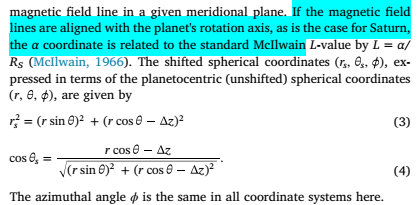Introduction
A planetary magnetic field $\vec{B}$ can be described outside of the planet using Gauss coefficients $g_n^m$ and $h_n^m$ and a spherical harmonic expansion:
$$\vec{B} \;=\; -\vec{\nabla} V(r,\theta,\phi)$$
and
$$V(r,\theta,\phi) \;=\; \sum_{n=1} \sum_{m=0}^l R_p \left(\frac{R_p}{r}\right)^{n+1} \big[g_n^m \cos(m\phi) + h_n^m \sin(m\phi) \big] P_n^m(\cos\theta) \text{,}$$
where $R_p$ is the planetary radius and $P_n^m(\cos\theta)$ are the associated Legendre polynomials.
If we assume the magnetic field is axially symmetric, then only the $m=0$ terms remain:
$$\begin{align} V(r,\theta,\phi) \;=&\; \sum_{n=1} R_p \left(\frac{R_p}{r}\right)^{n+1} g_n^0 P_n^0(\cos\theta) \\ =&\; \sum_{n=1} R_p \left(\frac{R_p}{r}\right)^{n+1} g_n^0 P_n(\cos\theta) \text{,}\end{align} $$
where $P_n^0(\cos\theta) = P_n(\cos\theta)$ are the Legendre polynomials.
My Question
Suppose I have the axisymmetric Gauss coefficients (say, $g_n^0$ for $1 \le n \le N$) for a given planet in a coordinate system centered on the planet. Let's suppose the magnetic equator is located northward from the planet's equatorial plane by a distance $\Delta z$, which implies the magnetic field is not symmetric about the planet's equator.
I want to treat the magnetic field as a dipole, probably in a coordinate system shifted northward along the polar axis by $\Delta z$. How could I calculate from those coefficients the "best-fit" dipole field in the shifted coordinate system?


